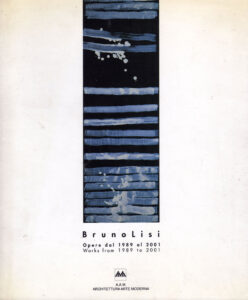Sometimes when you meet a person for the first time, you are instantly reminded of someone else, someone lost to the years and the space of continents. Bruno Lisi was just such a person for me. Before I had even decided whether I liked him or not, or reflected on my instinctive response to his art, my thoughts flew to a Portuguese man whom I had met some years before in Maputo, Mozambique. One might assume therefore that I liked Bruno immediately because I connected him with a friend from the past. But that wasn’t actually the case because I didn’t particularly like Cabral. I went round with him in Maputo more because I was forced to than because of any natural bond or shared tastes, although I was fascinated by his curious habit of expressing his thoughts but at the same time not expressing them, of alluding to something but remaining silent on the substance. Bruno’s clarity of expression, on the other hand, cannot be denied. And yet the likeness wasn’t just physical – it had to do with their way of looking at things, with a certain melancholic or distant smile, and perhaps something else which I can’t quite put my finger on right now. I became acutely aware of it one evening when I was invited to dinner at the house Bruno then shared with his wife Ida. Watching him commenting on the paintings and sculptures as if they no longer related to him, seeing him there next to his beautiful wife, I suddenly realised that Cabral, whom I had never liked that much, was a brilliant and likeable friend whom I would probably never see again but of whom I would preserve a keen memory – although, to be honest, my memory of Makonde was more intact. Makonde was a charming girl who every so often dropped in on Cabral bearing an array of strange and vaguely bitter sweets. It was that very evening that Bruno asked me to write something about his latest sculptures in methacrylate, which immediately struck me as intense but at the same time distant, non-material and abstract in the most meaningful sense of the term. The first thing that came to my mind, while I sat there sipping my coffee, was the title, which goes like this: “the spatiality of passion”.
Then I wanted to remark on how the void had been incorporated into the actual body of the sculpture. Indeed, we are dealing with the transformation of a void into an object, a heavy form, which is as structurally impending as only a square block of transparent material could be. The rhythmic articulation of the methacrylate panels evokes a sort of multifold depth marked by transparent sections, a layered void, the paradoxical negation of its very self. A concrete cage where colour constitutes itself as a negation of emptiness and the undemonstrable offspring of the diffusing light that assails and invades it.
The void coincides with the unsustainable density of the block and is transformed into heavy material through what the eye perceives as its layers of non-existence. And thus a work which would seem to be an apologetic celebration of the void ends by demonstrating its improbability.
Then I felt the need to write something about Lisi’s older works. Lisi appeared to be fascinated by the nervous solitude of colour, to the extent of suspending every distraction which failed to coincide with the dynamic substance and movement that conformed to it. The emptiness of the white canvas highlighted the passionate skeleton, with its closely-woven, sharply-defined fibres.
Only the structuring of emptiness could convey the wrenching solitude of colour and all its consequences. Lisi originally created the three-dimensional articulation in small formats (in polypropylene not methacrylate) which experimented with the efficacy of a new spatial organisation of colour, later to be fixed in the sumptuous “invasiveness” of the blocks of methacrylate.
Thus the methacrylate structures are not just containers of colour – they sublimate its ironic encapsulation, leading, in Lisi’s latest works, to its transformation into Nature. The spatiality of passion, which fermented between the folds of chromatic dynamism, lends itself to the paradoxical estrangement of the transparent block transformed into ‘landscape’, that is, a guarded structure protected from all forms of ideology, even an ecological one. The void therefore becomes a trick of form, pretending to be split from colour but in reality acting as a frozen bed on which it can manifest itself in all its most unpredictable aspects, to the extent of recovering with unexpected poetic shivers the most exploited image in the whole history of art – the landscape.
That was how my piece ended. A long time passed before I saw Bruno again. I bumped into him in Via del Babbuino with Irene. He asked me to publish the piece I wrote back then in his new exhibition catalogue. I told him he was free to do as he pleased with the article but immediately added that I would prefer to edit it slightly, given the time that had passed (if you don’t look time in the face, it shoots you in the back).
Seeing him with Irene, I immediately thought how women are able to mark the rhythm of life, giving it the cadence of their presence and if necessary their abandon. My thoughts again returned to Cabral, to Makonde, to Leinita in Maputo who would never give me her real phone number, and Ida – whom I never saw again. I lit a cigar and started walking towards Piazza di Spagna…
(translated by Michele Von Büren)
(from the catalogue of the exhibition: “Opere dal 1989 al 2001”, Galleria A.A.A. Palazzo Brancaccio, 26 November 2001-26 February 2002)
